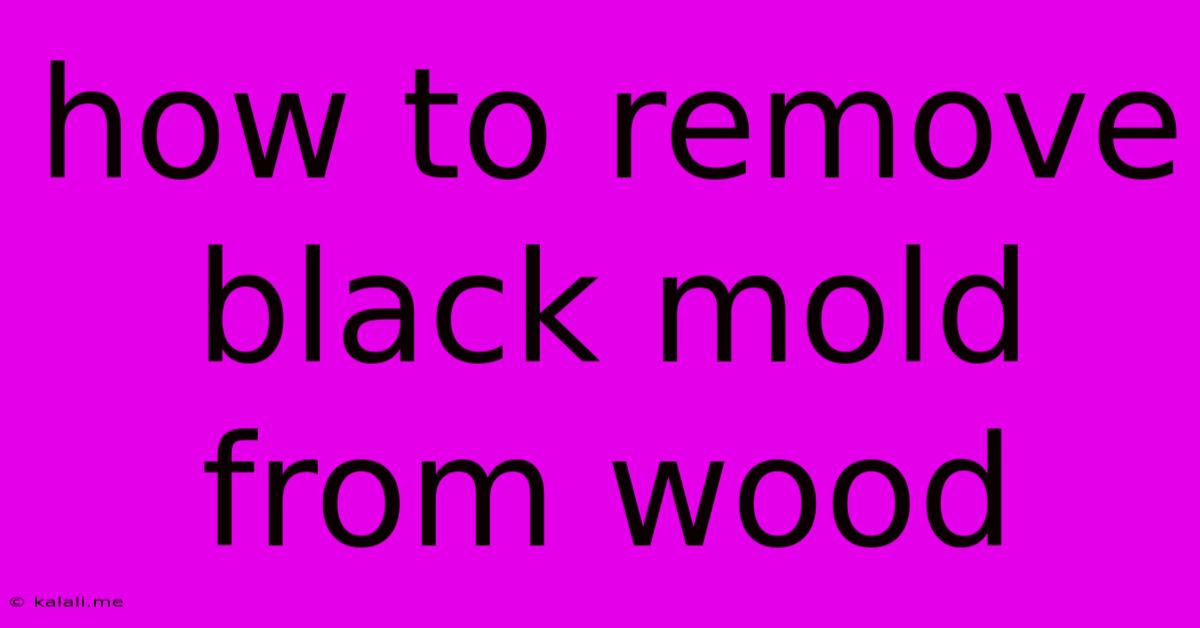How To Remove Black Mold From Wood
Kalali
May 30, 2025 · 3 min read

Table of Contents
How to Remove Black Mold from Wood: A Comprehensive Guide
Black mold on wood is not just unsightly; it's a potential health hazard. This guide provides a safe and effective method for removing black mold from wooden surfaces, minimizing your risk of exposure and preventing future growth. Remember: Always prioritize safety when dealing with mold. If the infestation is extensive or you're unsure about any aspect of the process, consult a professional mold remediation specialist.
Understanding Black Mold and its Dangers
Black mold, often Stachybotrys chartarum, thrives in damp, dark environments. It releases mycotoxins, which can trigger allergic reactions, respiratory problems, and other health issues, especially in vulnerable populations like children and the elderly. Early detection and prompt removal are crucial. Identifying the source of moisture is equally important to prevent recurrence.
Assessing the Mold Infestation
Before you begin, assess the extent of the mold growth. Is it a small patch, or is it widespread? The severity will influence your cleaning approach. A small, superficial infestation can often be handled with DIY methods, while larger infestations may require professional intervention.
Safety First: Protective Gear
Essential protective gear is non-negotiable:
- N95 respirator mask: This is critical to prevent inhaling mold spores. A simple dust mask is insufficient.
- Rubber gloves: Protect your hands from the mold and cleaning solutions.
- Eye protection: Safety glasses or goggles will prevent mold or cleaning solution from getting into your eyes.
- Protective clothing: Long sleeves and pants will protect your skin.
Cleaning Supplies You'll Need
Gather these materials before starting:
- Cleaning solution: A mixture of water and bleach (1 part bleach to 10 parts water) is commonly used, but other effective solutions include white vinegar or a commercial mold killer. Always test any cleaning solution on an inconspicuous area first to check for damage to the wood.
- Scrub brush: Choose a brush with stiff bristles suitable for wood but gentle enough to avoid scratching.
- Spray bottle: To easily apply the cleaning solution.
- Shop towels or rags: To wipe away the mold and cleaning solution.
- Plastic sheeting: To contain the mold and prevent its spread during cleaning.
- Vacuum with a HEPA filter: To remove loose mold spores after cleaning.
Step-by-Step Mold Removal Process
- Prepare the area: Isolate the affected area using plastic sheeting to prevent the spread of mold spores. Open windows to improve ventilation, but avoid creating drafts that could spread spores.
- Apply the cleaning solution: Gently spray the affected area with your chosen cleaning solution. Allow it to sit for 10-15 minutes to penetrate the mold.
- Scrub the mold: Using the scrub brush, gently scrub the affected area to remove the mold. Work methodically, ensuring you cover the entire affected area.
- Rinse the area: Thoroughly rinse the area with clean water to remove all traces of the cleaning solution and mold.
- Dry the wood completely: Thoroughly dry the wood with clean towels or allow it to air dry completely. A fan can speed up the drying process.
- Vacuum: Use a vacuum with a HEPA filter to remove any remaining mold spores from the surrounding area.
- Dispose of materials safely: Dispose of all cleaning materials and used rags carefully. Bag them securely and label them as contaminated waste.
Preventing Future Mold Growth
Addressing the source of moisture is crucial. Identify and fix leaks, improve ventilation, and use a dehumidifier in damp areas. Regularly inspect your wooden surfaces for signs of moisture or mold growth. Proper maintenance and timely cleaning will prevent future infestations and protect your health.
When to Call a Professional
If the mold infestation is extensive, covers a large area, or if you experience any health problems after attempting to remove the mold yourself, consult a professional mold remediation specialist. They possess the expertise, equipment, and safety protocols to handle complex mold situations effectively and safely. Remember, your health is paramount.
Latest Posts
Latest Posts
-
How To Heat French Bread In Oven
May 31, 2025
-
How To Find Date Of Creation Google Document
May 31, 2025
-
What Type Of Modifier Is Stealthily Dnd
May 31, 2025
-
Best Android Music Player For Shuffle Play
May 31, 2025
-
Pdf Bookmarks Always Single Page View
May 31, 2025
Related Post
Thank you for visiting our website which covers about How To Remove Black Mold From Wood . We hope the information provided has been useful to you. Feel free to contact us if you have any questions or need further assistance. See you next time and don't miss to bookmark.